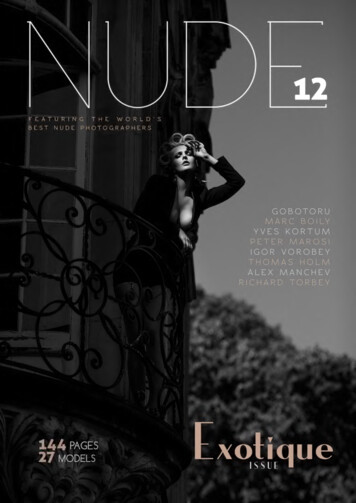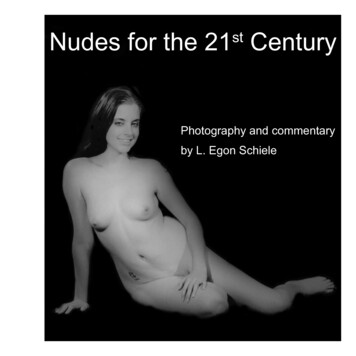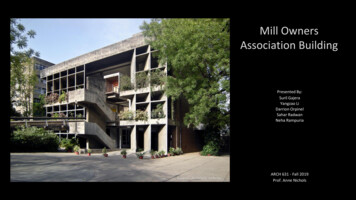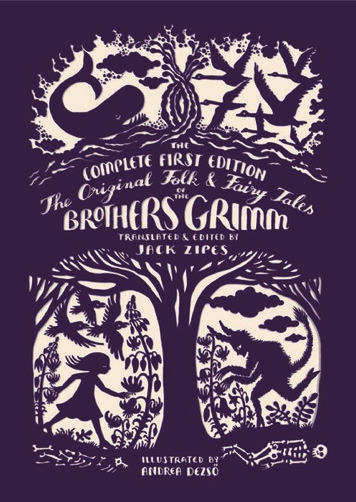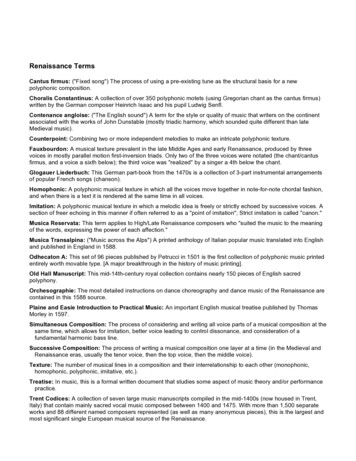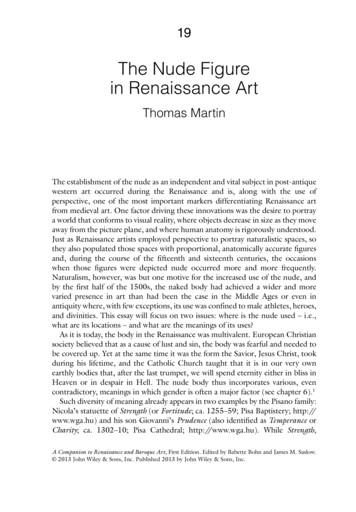
Transcription
19The Nude Figurein Renaissance ArtThomas MartinThe establishment of the nude as an independent and vital subject in post-antiquewestern art occurred during the Renaissance and is, along with the use ofperspective, one of the most important markers differentiating Renaissance artfrom medieval art. One factor driving these innovations was the desire to portraya world that conforms to visual reality, where objects decrease in size as they moveaway from the picture plane, and where human anatomy is rigorously understood.Just as Renaissance artists employed perspective to portray naturalistic spaces, sothey also populated those spaces with proportional, anatomically accurate figuresand, during the course of the fifteenth and sixteenth centuries, the occasionswhen those figures were depicted nude occurred more and more frequently.Naturalism, however, was but one motive for the increased use of the nude, andby the first half of the 1500s, the naked body had achieved a wider and morevaried presence in art than had been the case in the Middle Ages or even inantiquity where, with few exceptions, its use was confined to male athletes, heroes,and divinities. This essay will focus on two issues: where is the nude used – i.e.,what are its locations – and what are the meanings of its uses?As it is today, the body in the Renaissance was multivalent. European Christiansociety believed that as a cause of lust and sin, the body was fearful and needed tobe covered up. Yet at the same time it was the form the Savior, Jesus Christ, tookduring his lifetime, and the Catholic Church taught that it is in our very ownearthly bodies that, after the last trumpet, we will spend eternity either in bliss inHeaven or in despair in Hell. The nude body thus incorporates various, evencontradictory, meanings in which gender is often a major factor (see chapter 6).1Such diversity of meaning already appears in two examples by the Pisano family:Nicola’s statuette of Strength (or Fortitude; ca. 1255–59; Pisa Baptistery; http://www.wga.hu) and his son Giovanni’s Prudence (also identified as Temperance orCharity; ca. 1302–10; Pisa Cathedral; http://www.wga.hu). While Strength,A Companion to Renaissance and Baroque Art, First Edition. Edited by Babette Bohn and James M. Saslow. 2013 John Wiley & Sons, Inc. Published 2013 by John Wiley & Sons, Inc.
THE NUDE FIGURE IN RENAISSANCE ARTjjj403inspired by ancient Roman statues of the mythological hero Hercules, standsconfidently in his total frontal nudity, Prudence, based on ancient statues of the“modest” Venus (Venus pudica), cowers while trying to cover herself. That thenude can have radically different meanings, indicating strength or weakness, is adichotomy that reaches back to Mesopotamian art. The contrast between Nicola’spowerful male Strength and Giovanni’s fearful female Prudence confirms the rolethat gender plays in the representation of the unclothed body.Medieval iconography includes a limited number of subjects where the depictionof nudity was accepted: Adam and Eve, the Baptism and the Passion of Jesus, thesaints during their martyrdoms. In late medieval art, nakedness generally carriednegative meanings and its most common location was in depictions of the damnedin Last Judgment scenes, where the lost, naked souls exemplify what theologianscondemned as nuditas criminalis: nudity as an avenue to lust, vanity, and sin.Nonetheless, a new development in positive nudity first appeared on a regularbasis in Renaissance art in a religious context.Sacred NudityThat sacred context is the nudity of the Christ Child. Because Mary and her childis the most popular subject in Renaissance art, the convention of depicting babyJesus naked played a key role in the development of the genre. Although traditionaldepictions of a clothed Christ Child continued during the fourteenth century, inmany pictures from the same time period, baby Jesus has shed his garments andappears naked. Leo Steinberg rightly challenged the traditional, naturalisticexplanations for this change in the representation of the Christ Child, pointinginstead to theological reasons, principally the focus on Christ’s “humanation,”that is, the privileging in late medieval and Renaissance theology of the doctrineof the Incarnation (that with the birth of Jesus Christ, God took human form),much of it fired by the Franciscan emphasis on Christ’s humanity.2 We the viewers,just like the Magi, want to be assured that God is also truly man, in all his members,and the revelation of his naked body proves his human nature. There was noattempt here to emulate antiquity, or to incorporate “realism” into art.In Trecento Italy and elsewhere, the nude Christ Child appeared widely,primarily in small pictures made for domestic settings. During the Quattrocento,the motif emerged in monumental art; Masaccio’s Pisa altarpiece (1426; NationalGallery, London; http://www.wga.hu) is one example. Vasari reports thatMasaccio had a special interest in the nude, and he regularly depicts a nude ChristChild. By the second half of the fifteenth century throughout Italy, a clothed babyJesus, in either small-scale or monumental format, is relatively rare. Across theAlps, a nude baby Jesus was also standard in the art of both Jan van Eyck andRogier van der Weyden.By roughly 1450, then, the nude in the form of baby Jesus had an accepted,fixed place in southern and northern Renaissance art, both in public altarpieces as
404jjjTHOMAS MARTINwell as in domestic art, in both monumental and small-scale works. If the mostsacred body in history can be shown completely nude, even exposing the genitals,could not other bodies be shown nude as well?The meaning of the naked Baby Jesus is traditional: he embodies nuditasvirtualis, symbolizing innocence and purity, like the youthful Isaac bound andawaiting sacrifice on Ghiberti’s competition relief for the Baptistery doors inFlorence (1401; Bargello, Florence; http://www.wga.hu), whose nudity manifestshis vulnerability and helplessness. Allegorical figures also fall into this category; anexample in small-scale media is the half-naked female posed next to the unicornon the reverse of Pisanello’s medal of Cecilia Gonzaga (1447): she representsinnocence and chastity.But these are isolated examples. Ghiberti never made an independent nudefigure. Donatello was a more innovative artist; his bronze David (ca. 1440–60;fig. 6.3) remains the only totally nude sculptured David until Michelangelo’s(1501–04). Nonetheless, the nude plays only a minor role in Donatello’s art, nordid his David foster the making of large-scale nude statues.By 1450, there were still few locations for the nude besides the Christ Childand an occasional, usually allegorical figure. Things changed, however, in thesecond half of the century with the advent of Antonio Pollaiuolo (ca. 1432–98).As part of his program to treat the human figure in a newly dynamic and emotionalway, he was the first artist to specialize in the nude, depicting the male nude inpainting, sculpture, and the graphic arts.His most important public painting was the Martyrdom of St. Sebastian (ca.1475; National Gallery, London; http://www.wga.hu), commissioned by thePucci family for the Oratory of St. Sebastian in the Florentine church of theSantissima Annunziata. One of the largest altarpieces of its time, it features at itsapex a St. Sebastian dressed only in a loincloth. Pollaiuolo’s most importantprivate paintings were the three Labors of Hercules (ca. 1460?); now lost, theywere the largest paintings in the Medici palace – like St. Sebastian, around ninefeet high – and presumably resembled the two small-scale Labors by the artist thatsurvive in the Uffizi and feature semi-naked men. His one surviving fresco, theDancing Nudes (1470s?) from the Lanfredini villa in Arcetri outside Florence(like the Pucci, the Lanfredini were Medici allies), shows a unique subject ofanonymous, nude, dancing men and women.Pollaiuolo’s Battle of the Nudes (ca. 1470; fig. 19.1), his only print, is a landmarkin Italian printmaking. Its large size (over a foot high and two feet wide), itsmedium (an engraving, not a humble woodcut), and its prominent signature (itis the very first signed Italian print), all demonstrate that the artist wanted tomake a big splash in a medium barely fifty years old that was not yet known for itsartistic sophistication; and he succeeded. Although the subject matter of this printremains unresolved, its wide dissemination shows the appeal of the nude and how,by the 1470s, it was already associated with antiquity.3 (The offspring ofPollaiuolo’s invention of battling naked men – such as Jacopo de’ Barbari’s largescale Triumph of Men over Satyrs [1490s] – demonstrate that nudity sometimes
THE NUDE FIGURE IN RENAISSANCE ARTjjj405FIGURE 19.1 Antonio Pollaiuolo, The Battle of the Ten Nudes, engraving, ca. 1470–75.Private collection / The Bridgeman Art Library.also signifies primitive humanity.) In another new medium, that of small bronzes,Pollaiuolo continued the association of nudity with antiquity in works such as theHercules and Antaeus (1470s?), which depicts the two muscular male nudes in adeath struggle.These examples in different media carry notably different meanings. Like Isaacon Ghiberti’s competition relief, St. Sebastian is another nudus virtualis, innocentand vulnerable. In Hercules and Antaeus, however, the heroic male body strugglesand fights. As in antiquity, the nude is a focus of agon, or heroic struggle: thenaked form embodies the struggle itself, and we see the inner strength of thehero’s spirit in the outer tension and flexing of his muscles. The meaning is similarto that of Nicola Pisano’s Strength, but now with intense emotion and pathos. Ina Christian context, Hercules would be “the athlete of virtue.”4The Dancing Nudes of Arcetri, by contrast, are Arcadian, depicting a kind ofrural, earthly paradise: they show the “joy of life,” whereas the Battle of the Nudesis brutal and violent.5 So Antonio Pollaiuolo not only broadened the locations ofthe nude to different media, but also widened the range of meanings and emotionsthat the unclothed body can convey.Pollaiuolo’s efforts were aided by patronage and technique. The Medici andtheir allies were important patrons for Pollaiuolo: did they actively encourage himto depict nudes or simply provide support for his own ambition to do so? Althoughthis topic needs further research, they certainly did the latter and probably also
406jjjTHOMAS MARTINthe former (see chapter 1). And a new artistic practice, life drawing, providedtechnical support for the new approaches to the nude. Surviving drawings byPollaiuolo demonstrate that he and his studio drew after the nude model in aprogrammatic way that had not been done before. The result was that not onlydid the nude appear more prominently in his art than previously, but the studyand representation of the naked body was now also an integral part of the artist’straining (see chapter 8).New MediaThe advent of the “artistic” print after 1450, however, was of far greaterimportance for the development and diffusion of the nude in Renaissance art thanwere Pollaiuolo’s individual efforts (see chapter 12). Because making a print costsmuch less than making a painting (or statue), prints allowed artists to exploreunusual subject matter unlikely to be commissioned for more monumental media.Prints hence became the place where the Renaissance artist, often constricted bypatronal control, could exert his creative freedom and even invent his ownsubjects, as Pollaiuolo did in the Battle of the Nudes.Andrea Mantegna (ca. 1431–1506) in Mantua responded quickly to Pollaiuolo’spioneering efforts. His three prints that depict non-religious subject matter, allfrom the early 1470s – the Bacchanal with a Wine Vat, the Bacchanal with Silenus,and the Battle of the Sea Gods (the last sometimes interpreted as a satirical reply toPollaiuolo; http://www.wga.hu) – share striking similarities with Pollaiuolo’sBattle of the Nudes. All four are engravings in large format, demonstrating theirintent to compete with paintings. Furthermore, all four are inventions by theartist and depict a naked cast of characters.Significantly, these images by Pollaiuolo and Mantegna do not fit into thetraditional, theological categories of nuditas criminalis or nuditas virtualis, showingthat the artistic depiction of nudity had reached a new autonomy, usually throughthe evocation of antiquity. In a dialogue by Angelo Decembrio (ca. 1450s), Leonellod’Este, ruler of Ferrara, remarks more than once on how the greatest works ofantiquity depict nude figures. Why? It is because the nude shows the artist’s masteryof nature, which clothes would only obscure: “the artifice of Nature is supreme, noperiod fashions change it.”6 Renaissance artists sometimes pushed that legacy evenfurther, depicting scenes from antiquity in which the characters are nude although,in antiquity, those characters would have been clothed.The freedom to invent offered by the medium of prints allowed artists toexplore and recreate antiquity, and to display their mastery of the naked humanfigure in ways that otherwise would have been difficult. Nudes set in the ancientworld avoided the incongruity of depicting contemporary nudity, and amythological/pagan setting also evoked a sexual freedom and oneness with natureconducive to the depiction of nudity. Perhaps the greatest statement of this kindis Raphael and Marcantonio Raimondi’s engraved Judgment of Paris (ca.1517–20;
THE NUDE FIGURE IN RENAISSANCE ARTjjj407http://www.wga.hu), which, according to Vasari, “stunned” all of Rome. (Raphaelused a relief in the Villa Medici as his chief source; in the ancient relief, thegoddesses are clothed.)Nudity quickly became the norm in the small bronze as well. Although thechronology of early bronzes is very approximate, several that are commonly datedbetween 1450 and 1500 depict naked figures. Bertoldo de’ Giovanni, a memberof Lorenzo de’ Medici’s circle, made several small bronzes of nudes. Here again,a Medici role in encouraging the revival of antiquity – and thus of the nude –seems probable.Because prints and bronzes are small-scale media that a collector examines inthe privacy of his or her studiolo (personal office), the demands of decorum arelooser and the depiction of pagan, naked figures is safe from public scrutiny orcensure. As Carlo Ginzburg has pointed out, there were two distinct “iconiccircuits” during the Renaissance. One was public and cut across social classes:statues, frescoes, and paintings in churches and other public places. The secondwas private and restricted to the social elite: small paintings, gems, bronzes, andmedals in homes of the wealthy and the educated.7By the last third of the 1400s, then, the depiction of nudity had found newlocations, uses, and meanings in Italian art. From this time comes the body typethat still today reigns supreme in western visual culture (particularly in underwearads): young and classically inspired, hence fit, and generically idealized. It canappear in various subjects and situations, not solely in those iconographicallysanctioned by ecclesiastical tradition. The rise of the nude paralleled andaccompanied the growing secularization of western art and the increasingimportance of the secular patron8 (see chapter 1). Critics of this developmentwere not wanting, however, for even humanists like Erasmus, in his DialogusCiceronianus (1528), excoriated the self-professed classical purists (“Ciceronians”)who want everything in the antique style.The Netherlandish Fifteenth-Century NudeThe founder of northern Renaissance art, Jan van Eyck, vividly expressed hisinterest in the nude with the figures of Adam and Eve on the Ghent altarpiece(1426?; St. Bavo, Ghent; http://www.wga.hu). Although a nude Adam and Eveshown after the Fall is a traditional subject, their startling physicality is new,testifying to close study of actual models.Also important is the gender difference. Whereas Adam’s foot steps beyond theframe of his niche, Eve’s hugs the border; though both of Adam’s legs are visible,only Eve’s front leg can be seen, making her pose more unstable; Adam’s bone andmuscle structure are well defined, while the surface of Eve’s flesh is highlighted. Likethe contrasts noted above between Nicola Pisano’s Strength and Giovanni Pisano’sPrudence, those between van Eyck’s first man and first woman imply a concern withgender differences: men are active, women passive; men are strong, women beautiful.9
408jjjTHOMAS MARTINVan Eyck also explored the nude in secular settings. In 1456, BartolomeoFazio, a Neapolitan humanist, published a book about Famous Men, in which hedescribes a painting by van Eyck of a women’s bathhouse. The painting’s mostwonderful feature, he states, was a mirror that revealed the back of one of thewomen, even though only her upper body was visible from the front.10 TheArnolfini Wedding (1434; National Gallery, London; http://www.wga.hu)confirms van Eyck’s special affinity for mirrors that not only proclaim the mimeticpower of the artist but also show how the art of painting itself mirrors reality. Themirror in the bathhouse picture must have functioned in a similar way. It is lost,but a copy survives of another lost painting by van Eyck of a nude.The copy, called Woman at Her Toilet (Fogg Art Museum, Cambridge, MA;http://nrs.harvard.edu/urn-3:HUAM:49152 mddl), shows a frontally nudewoman in a domestic interior, accompanied by a clothed woman on the right.The nude woman holds a washcloth over her genitals with her left hand, while herright hand reaches for a wash basin on her right. A convex mirror, like the one inthe Arnolfini Wedding, hangs on the window above the basin and reflects bothwomen. An important issue here is the relationship between viewer and subject.One of the most powerful effects of perspective is that the viewer can seem to beplaced in the space of the picture. Just as the viewer witnesses the ArnolfiniWedding by being in the same room as its occupants, so is the viewer present inthe Woman at Her Toilet. That the viewer is a voyeur is inherent in the very natureof representational, naturalistic art. When, however, does the voyeurism becomemanipulative or exploitative? Such issues have been raised and explored only inthe last fifty years, especially in the work of feminist critics. Van Eyck’s Woman atHer Toilet could be considered an early example of what has been called the malegaze: a painting commissioned by a man in which the patron gets to see, andimplicitly to possess, a naked woman exposed to his view (see chapter 6).In most northern art of the 1400s, the location of the nude remains in traditional,religious subjects. In medieval art, however, the bathhouse or fountain of youthwas already a secular category where sex and eroticism ruled. Van Eyck’s Woman atHer Toilet comes out of this tradition, with the innovation that whereas earlierbathhouse images always showed men and women cavorting together, his pictureisolates the female nude. Indeed, van Eyck’s pictures and the emulation theyinspired were one of the factors leading to the depiction of the female nude inItalian art.11The Female Nude in ItalyIn Italy, the focus on the male nude spearheaded by Pollaiuolo shifted to a newattention to the female nude. Botticelli’s Birth of Venus (1480 s?; fig. 19.2) withits centralized, frontal, almost life-size nude goddess is one example. Its subjectderives from verses in the Stanze by the Florentine humanist Angelo Polizianothat describe a relief on the doors of the palace of Venus depicting the new-borngoddess of love and beauty arriving on the shore of Cyprus. Hence the nudity is
THE NUDE FIGURE IN RENAISSANCE ARTjjj409FIGURE 19.2 Sandro Botticelli, Birth of Venus, 1480s. Uffizi, Florence. Photo Giraudon /The Bridgeman Art Library.appropriate to the subject: Venus was born naked and then clothed by nymphs onher arrival at Cyprus. She also conforms to the established convention thatantiquity equals nudity, reinforced by the derivation of her pose from the ancientstatue known as the “modest” Venus (Venus pudica).But while Botticelli’s original undoubtedly had allegorical meaning, such as thebirth of beauty in the world, it spawned variations with clearly different purposes.Three pictures survive from Botticelli’s workshop (there surely were many more)that lift the figure of Venus out of any context and isolate her against a plain blackbackground.12 Shorn of narrative trappings as well as her clothing, the figure hereis not Venus but an anonymous, beautiful, naked woman, presented in an openlyerotic way. Such pictures must have been what Vasari was talking about when henoted the many images of naked women (“femmine ignude assai”) produced byBotticelli.13 That their purpose was for a market in erotica is clear not only fromthe images themselves but also from how they were made. In the variants in Berlinand Turin, the contours of the body of “Venus” are identical from the neckdownwards, and match the contours of their source figure in the Birth of Venus,indicating that a cartoon (or stencil) was used, i.e., these variants were meant tobe reproduced easily, indicating that demand for them was high.These variants are the origin of the standing, isolated female nude, furtherexamples of which are seen in the “Venuses” by Lorenzo di Credi (early 1500s?;Uffizi, Florence; http://www.wga.hu) and Brescianino (1520s?; BorgheseGallery, Rome; http://www.wga.hu). Even though the works just mentionedseem to have been made for the titillation of the male patron, they differ in
410jjjTHOMAS MARTINsignificant ways. The pictures from Botticelli’s workshop and Brescianino showidealized, generic nobodies, whereas Credi’s figure bears individualized featuresclearly taken from a model. So even in pictures seemingly made for the samemarket and belonging to the same genre, the approach can differ significantly.Hence, caution should be observed before lumping such images simplisticallyinto the same category, and interpreting them in an identical way, especially when,as is usually the case, we know nothing about the commissions (or dates) of theseworks.The female nude also came to prominence in Venice at the beginning of the1500s, spearheaded by Giorgione (ca. 1478–1510). Despite the attributionalproblems around this artist’s oeuvre, nudity or partial nudity appears in four ofthe very few works universally given to him: the Laura (1506), the Tempest(1506?), the ruined frescoes for the Fondaco dei Tedeschi (1507–08), and theSleeping Venus (1510?; Gemäldegalerie, Dresden; http://www.wga.hu).Giorgione’s special interest in the nude led to innovations, the most important ofwhich is the Sleeping Venus (probably finished by Titian) where he invented thereclining female nude in a landscape.14Her total nudity, her passivity in relation to the viewer, her identification withnature, have all spawned numerous important legacies in art and in gendertypologies. While the Sleeping Venus may have been commissioned for the 1507marriage of Gerolamo Marcello, variants with different meanings appearedquickly, such as Palma Vecchio’s Venus (ca. 1520s; Gemäldegalerie, Dresden;http://www.wga.hu). While Giorgione’s Venus was originally accompanied byCupid (painted out of the right corner in the 1830s), and lies on splendid satinsas befits a goddess, Palma’s “Venus” is a mortal woman who has gone into thewoods and taken her clothes off; she clearly lies on the garment she has justremoved and looks out at the viewer. The sequence of events is like that seen withthe Birth of Venus: the custom-made example provides the model for the variantsfashioned for different purposes and aimed at a broader market. Additionaleroticization of Giorgione’s model appears when the nude is taken out of thelandscape and placed in her bedroom; this happened in 1538 with Titian’s Venusof Urbino, the interpretation of which is much contested (fig. 6.2).15Overtly erotic female nudity was furthered in Venice (and elsewhere) in theearly sixteenth century with the appearance of the so-called “courtesan portrait”that frequently featured nude, or partially nude, women. An early example isGiorgione’s Laura who bares her right breast. It is unclear whether the Venetianimages spawned by Laura relate to the most influential example of this type,which was an unfinished work by Leonardo, now known only through copies: aportrait of Giuliano de’ Medici’s mistress shown topless in a pose and formatderived from the Mona Lisa. Because Leonardo took this painting to France atthe end of his life, it provided the model for the genre, particularly associated withthe School of Fontainebleau, of the nude woman in her bath, seen half-length.A significant example is François Clouet’s Woman in Her Bath (ca. 1570; NationalGallery of Art, Washington; http://www.wga.hu). Similar images were produced
THE NUDE FIGURE IN RENAISSANCE ARTjjj411in Rome as evidenced by Raphael’s Fornarina (1518–19). Zerner has given themost thoughtful treatment of this subject, concluding that, at least in France, thegenre seems confined to women who were royal mistresses, and hence was“reserved for very particular circumstances.”16Nude PortraitsMost of these females in the “courtesan” pictures bear features that are so generic –and often so similar – that it seems unlikely that they depict historical people.Nonetheless, there are some clearly identifiable nude portraits in the Renaissancethat yet again demonstrate how varied the meaning of bare flesh can be.Nude portraits first appear in medals, in emulation of ancient numismaticpractice; the earliest depicts the profile and bust of Francesco II Carrara of Padua(ca. 1390), whose shoulders are bare, just like those of the Emperor Vitellius inits ancient model. The intent is straightforward: to appropriate imagery from thepast, thereby investing the modern-day rulers with an aura of imperial romanitas.Similar appropriation of the glories of antiquity was again the goal when artistslike Giovanni Boldù (1458) and Donato Bramante (1505) depicted themselveson medals as if nude. Andrea Guacialoti’s medal of Bishop Niccolo Palmieri(1467) aims at a different meaning, as shown by the verse from the book of Jobthat encircles his profile: “Naked came I from my mother’s womb and naked willI return,” i.e., the emphasis is on the humility of the sitter before God rather thanon appropriation of secular vainglory.17Pliny the Elder’s Natural History relates that in ancient Rome a portrait sometimesdepicted a person “as” someone else, a practice followed in the Renaissance;Bronzino’s Cosimo I as Orpheus (ca. 1537–39) and Andrea Doria as Neptune(1530s–40s) are examples. Because the bodies in both of the above cases are muscularand complimentary (Cosimo’s is based on the Hellenistic marble Belvedere Torso),the purpose is apparently to honor the sitter by idealizing his body. The sameapproach governs Andrea Riccio’s reliefs from the tomb of Marcantonio andGirolamo Della Torre (ca. 1516–21; Louvre, Paris; http://www.lessing-photo.com/search.asp?a I&kw andrea riccio&l E&m 0&p 2&ipp 6). In GirolamoTaken Ill and The Death of Girolamo, the subject’s splendidly nude body is clearlybased on classical examples. Many courtesan/mistress portraits also display perfectbodies, raising the possibility that their intent might also have been honorific, notsimply airbrushing a female body into objectification.Once again, things were different in the north. Albrecht Dürer made threedrawings of himself nude, none of which show him with a glorious physique.Matthäus Schwarz, chief bookkeeper for the Fugger banking family inAugsburg, decided to include in his Book of Costumes a nude portrait of himselfseen from both front and back along with various clothed portraits; theilluminations are by Narcissus Renner (Herzog-Anton-Ulrich Museum,Braunschweig; http://www.mediafire.com/?cbo3krr9x54rurn). Both views of
412jjjTHOMAS MARTINSchwarz show a distinctly unidealized body, and the exact date of July 1, 1526appearing on the image (like those on some van Eyck portraits) implies that itwas meant to be documentarily accurate. In these examples, nudity equals truthand honesty, as it does metaphorically at the beginning of Michel de Montaigne’sEssays, where the French writer claims he would gladly depict himself nakedwith all his faults.18The mortality and even the destruction of the human body are not the usualfocus of nudes, or of portraits, yet that is what the northern European mode offunerary sculpture called the transi emphasizes, in which the deceased is shownon his or her tomb as dead and decaying. Starting in the second half of thefourteenth century, such images appear on numerous tombs in England, France,and Germany; the type is rare in Italy. Although sometimes the corpses appear stillwrapped in their shrouds, others are nude. Panofsky connected the rise of thisphenomenon to the “general preoccupation with the macabre” seen all overEurope after the Black Death of 1348; he also coined the happy phrase “doubledecker” tomb to identify the monuments where a transi contrasts with an imageof the deceased as still alive.19 In Antonio and Giovanni Giusti’s tomb of LouisXII of France and Anne of Brittany in the royal funeral chapel at St. Denis(1515–31; http://commons.wikimedia.org), the king and queen appear on top ofthe monument, kneeling before prayer benches as if alive. Below, they lie astransis, naked, dead, with their torsos sewn back up after having been cut open toremove their hearts and intestines. Death is the great equalizer: in transi figuresthere is no visual distinction between genders.MichelangeloNo Renaissance artist is more closely identified with the naked human body thanMichelangelo, whose preoccupation with the genre, coupled with his immenseprestige, fostered greater acceptance of and support for the de
The establishment of the nude as an independent and vital subject in post-antique western art occurred during the Renaissance and is, along with the use of perspective, one of the most important markers differentiating Renaissance art from medieval art. One factor driving these innovations was the desire to portray


